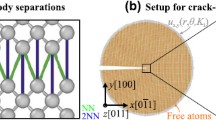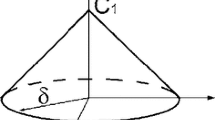Abstract
The purpose of the work is (a) a rigorous formulation of the brittle fracture problem from the thermodynamic point of view and (b) widening the theory by accounting for not only surface tension, but also the line tension of a crack. A proper thermodynamic formulation of the Griffith problem is attained by introducing generalized Gibbs energy as a thermodynamic potential, both the 2d and 3d cases being included. Thermodynamic line tension is introduced as a new characteristic of a crack originating from changing surface tension near the crack tip, which can be of certain significance for nanocracks. The criterion of rupture is reformulated in the context of line tension. As an example, a detailed calculation of the surface and line tensions of a crack is performed for a molecular solid with dispersion forces. The effect of line tension on the ultimate strength is shown to be twice as much in the 3d case as compared with the 2d case.
Similar content being viewed by others
References
Brodskaya EN, Rusanov AI (2009) Pressure tensor in wedge-shaped cavity of solid with dispersion forces. Colloid J 71: 22–30
Cherepanov GP (1979) Mechanics of brittle fracture. McGraw Hill, New York
Chiang C-R (2004) Some crack problems in transversely isotropic solids. Acta Mech 170: 1–9
Chudnovsky A (1984) Statistics and thermodynamics of fracture. Int J Eng Sci 22: 989–997
Eftis J, Liebowitz H (1976) On surface energy and the continuum thermodynamics of brittle fracture. Eng Fract Mech 8: 459–485
Gibbs JW (1906) The scientific papers. Longmans, New York
Griffith AA (1921) The phenomena of rupture and flow in solids. Phil Trans A 221: 163–198
Gurtin ME (1979) Thermodynamics and the Griffith criterion for brittle fracture. Int J Solid Struct 15: 553–560
Hatzitrifon NK, Gdoutos EE (1988) On the Griffith criterion for three-dimensional cracks. Int J Eng Sci 26: 833–836
Huet C (1997) An integrated micromechanics and statistical continuum thermodynamics approach for studying the fracture behaviour of microcracked heterogeneous materials with delayed response. Eng Fract Mech 58: 459–556
Irving JH, Kirkwood JG (1950) The statistical mechanical theory of transport processes. IV. The equations of hydrodynamics. J Chem Phys 18: 817–829
Mahanty J, Ninham BW (1976) Dispersion forces. Academic Press, London
Margolin LG (1984) A generalized Griffith criterion for crack propagation. Eng Fract Mech 19: 539–543
Maugin GA (1992) The thermomechanics of plasticity and fracture. Cambridge Univ Press, Cambridge
Murrell SAF, Digby PJ (1972) The thermodynamics of brittle fracture initiation under triaxial stress conditions. Int J Fract Mech 8: 167–173
Orowan E (1944) The fatigue of glass under stress. Nature 154: 341–343
Polizzotto C (2002) Thermodynamics and continuum fracture mechanics for nonlocal-elastic plastic materials. Eur J Mech A/Solids 21: 85–103
Rice JR (1978) Thermodynamics of the quasi-static growth of Griffith cracks. J Mech Phys Solids 26: 61–78
Rusanov AI (1978) On the thermodynamics of deformable solid surfaces. J Colloid Interface Sci 63: 330–345
Rusanov AI (1996) Thermodynamics of solid surfaces. Surf Sci Rep 23: 173–247
Rusanov AI (2000) Thermodynamic fundamentals of mechanochemistry. Rus J Gen Chem 70: 329–356
Rusanov AI (2005) Surface thermodynamics revisited. Surf Sci Rep 58: 111–239
Rusanov AI, Kuni FM (1971) Distribution functions and pressure tensor of the film of a simple fluid. In: Derjaguin BV (ed) Research in surface forces. Consultants Bureau, New York–London, 3, pp 111–122
Sack RA (1946) Extension of Griffith’s theory of rupture to three dimensions. Proc Phys Soc 58: 729–736
Schapery RA (1964) Application of thermodynamics to thermomechanical, fracture, and birefringent phenomena in viscoelastic media. J Appl Phys 35: 1451–1465
Thomson R (1980) Theory of chemically assisted fracture. Part 1 General reaction rate theory and thermodynamics. J Mater Sci 15: 1014–1026
van der Varst PGTh, de With G (1995) Notes on the paper: a thermodynamic framework of fracture mechanics. Eng Fract Mech 51: 333–334
Zhang C, Karihaloo BL (1993) A thermodynamic framework of fracture mechanics. Eng Fract Mech 46: 1023–1030
Author information
Authors and Affiliations
Corresponding author
Rights and permissions
About this article
Cite this article
Rusanov, A.I. Brittle fracture: thermodynamic refinement of the Griffith problem. Int J Fract 161, 53–63 (2010). https://doi.org/10.1007/s10704-009-9428-2
Received:
Accepted:
Published:
Issue Date:
DOI: https://doi.org/10.1007/s10704-009-9428-2




